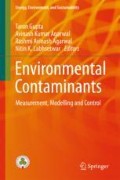Abstract
In the last few decades, due to the overuse of groundwater resources and human mismanagement, groundwater quality has been severely affected. If the quality is not safe, even if it is abundant, it is not useful. This chapter essentially deals with the nature and movement of contaminants in groundwater due to the transport mechanisms such as advection, dispersion, retardation, and other chemical reactions and its numerical modeling. The numerical modeling refers to the process of simulation where approximate solutions to the governing equation of contaminant transport are obtained. The numerical modeling of groundwater contamination had undergone much advancement over the past half century. The driving factors behind this continuous progress are due to the alarming change in groundwater quality due to different anthropogenic reasons leading to the need for more accurate and efficient groundwater remediation and management models. Further, due to the rapid development in computational techniques and powerful data processing systems, groundwater contamination modeling is made more easily available to hydrogeologists and engineers. This chapter gives an insight into the groundwater contamination process, from discussing contaminant transport mechanisms to challenges faced in its numerical modeling. The details of the governing partial differential equations and the evolution of the methodology in obtaining these approximate solutions using different numerical techniques are presented. The process of numerical simulation is demonstrated with the help of example problems, and the results are discussed and compared with solutions from different numerical models. The chapter highlights the need for the qualitative and quantitative reasoning behind the simulation of any contaminant transport problem and how the numerical modeling helps in identifying the best way of solving it. Finally, a field case study is given in which the numerical simulation provides an integrated framework wherein the conceptual principles are applied to the observed data and investigative and predictive calculations are done which helps in developing management and protection policies.
Access this chapter
Tax calculation will be finalised at checkout
Purchases are for personal use only
References
Anderson MP (1984) Movement of contaminants in groundwater: groundwater transport–advection and dispersion, groundwater contamination. National Research Council, National Academy Press, Washington D.C
Anderson MP, Woessner WW (1992) Applied groundwater modeling—simulation of flow and transport. Academic Press Inc., San Diego, California
Atluri SN (2004) The Meshless method (MLPG) for domain and BIE discretizations. Tech Science Press, Forsyth
Bear J (1972) Dynamics of fluids in porous media. Dover Books, New York
Bear J (1979) Hydraulics of groundwater. McGraw Hill Publishing, New York
Bear J, Verruijt A (1987) Modeling groundwater flow and pollution. D. Reidel Publishing Co., Dordrecht
Bedient PB, Rifai HS, Newell CJ (1999) Groundwater contamination-transport and remediation, 2nd edn. Prentice Hall, New Jersey, USA
Desai YM, Eldho TI, Shah AH (2011) Finite element method with applications in engineering. Pearson Education, New Delhi
Dhar RL, Rao VVSG, Subrahmanayam K, Yadaiah P, Govil PK, Gyaneswara Rao T, Keshavkrishna A (1998) Study of Groundwater Pollution in Patancheru and Bolaram Industrial Development Areas. Medak district, Andhra Pradesh. Technical Report: NGRI-99-GW- 252:127
Downing RA (1998) Groundwater—Our hidden asset. British Geological Survey Monograph
Eldho TI (2001) Groundwater contamination—the challenge of pollution control and protection. J Indian Water Works Assoc 33(2):171–180
Freeze RA, Cherry JA (1979) Groundwater. Prentice Hall, Englewood Cliffs
Fried JJ (1975) Groundwater pollution. Elsevier, New York
Guneshwor SL, Eldho TI, Kumar AV (2016) Coupled groundwater flow and contaminant transport simulation in a confined aquifer using meshfree radial point collocation method (RPCM). Eng Anal Bound Elem 66:20–33
Istok J (1989) Groundwater modeling by the finite element method. American Geophysical union, Washington
Kovářík K, Mužík J (2013) A Meshless solution for two dimensional density-driven groundwater flow. Eng Anal Bound Elem 37(2):187–196
Kumar P, Dodagoudar GR (2008) Two-dimensional modeling of contaminant transport through saturated porous media using the radial point interpolation method (RPIM). J Hydrol 16:1497–1505
Li H, Mulay SS (2013) Meshless methods and their numerical properties. CRC, Boca Raton
Li J, Chen Y, Pepper D (2003) Radial basis function method for 1-D and 2-D groundwater. Comput Mech 32:10–15
Liu GR, Gu YT (2005) An introduction to meshfree methods and their programming. Springer, Berlin
Mategaonkar M, Eldho TI (2012) Groundwater remediation optimization using a point collocation method & particle swarm optimization. Environ Model Softw 32:37–48
Pinder GF, Gray WG (1977) Finite element simulation in surface and subsurface hydrology. Academic press, New York
Rao VVSG, Dhar RL, Subrahmanyam K (2001) Assessment of contaminant migration in groundwater from an industrial development area, Medak district, Andhra Pradesh, India. Water Air Soil Pollu 128(3):369–389
Rastogi AK (2010) Numerical Groundwater Hydrology. Penram Int. Publishing, New Delhi
Sharief SMV, Eldho TI, Rastogi AK (2008) Optimal pumping policy for aquifer decontamination by pump and treat method using genetic algorithm. ISH J Hydraul Eng 14(2):1–17
Sharief SMV, Eldho TI, Rastogi AK (2012) Optimal groundwater remediation by pump and treat using FEN and EGA based Simulation—Optimization Model. J Hazard Toxic Radioact Waste, ASCE 16(2):106–117
Swathi B, Eldho TI (2014) Groundwater flow simulation in unconfined aquifers using Meshless Local Petrov-Galerkin (MLPG) method. Eng Anal Bound Elem 48:43–52
Swathi B, Eldho TI (2017) A moving least squares based Meshless Local Petrov-Galerkin method for the simulation of contaminant transport in porous media. Eng Anal Bound Elem 78:8–19
Wang H, Anderson MP (1982) Introduction to groundwater modeling finite difference and finite element methods. W. H. Freeman and Company, New York
Willis R, Yeh WW-G (1987) Groundwater systems planning and management. Prentice Hall, Inc. Englewood Cliffs, New Jersey
Zheng C, Bennett GD (1995) Applied contaminant transport modeling—theory and practice. Van Nostrand Reinhold, New York
Author information
Authors and Affiliations
Corresponding author
Editor information
Editors and Affiliations
Rights and permissions
Copyright information
© 2018 Springer Nature Singapore Pte Ltd.
About this chapter
Cite this chapter
Eldho, T.I., Swathi, B. (2018). Groundwater Contamination Problems and Numerical Simulation. In: Gupta, T., Agarwal, A., Agarwal, R., Labhsetwar, N. (eds) Environmental Contaminants. Energy, Environment, and Sustainability. Springer, Singapore. https://doi.org/10.1007/978-981-10-7332-8_8
Download citation
DOI: https://doi.org/10.1007/978-981-10-7332-8_8
Published:
Publisher Name: Springer, Singapore
Print ISBN: 978-981-10-7331-1
Online ISBN: 978-981-10-7332-8
eBook Packages: Earth and Environmental ScienceEarth and Environmental Science (R0)

